Purpose: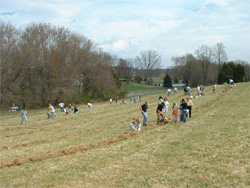
Loudoun Wildlife Conservancy and Loudoun Watershed Watch sponsored this event as part of the Catoctin Watershed Project to restore water quality in the Catoctin Creek watershed.
The Catoctin Creek, including the North and South Forks, are contaminated by fecal pollution from non-point sources, including livestock that have access to the streams.
The State has allocated over $1 million dollars in cost-share and grant funds for stream-side property owners to restore riparian buffers, keep livestock out of streams, and repair failing septic systems.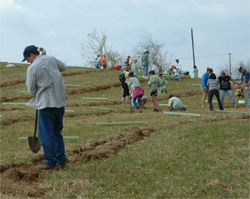
The purpose of this stewardship event was to help people understand that trees and natural riparian buffers help make our streams safe for recreational use, for use as corridors by wildlife, and as a healthy place for fish and other aquatic life
Organizers and Supporters:
The event was a success because of the help of several groups and individuals. Mark Moszak and Darrell Schwalm co-chaired the event for Loudoun Watershed Watch and Loudoun Wildlife Conservancy. Dana Malone, Loudoun County Forester, helped prepare the site and instructed the participants. Chris VanVlack, Loudoun County Soil and Water Conservation District, provided the tools and helped with the planting. Mark Novak, Loudoun County Parks, Recreation, and Community Service helped set up the event and provided support. The trees were provided by the Virginia Department of Forestry.
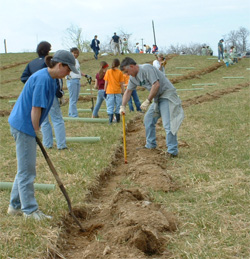 Highlights:
Highlights:
Environmental stewardship is alive in Loudoun County as shown by more than 80 Girl Scouts, leaders, parents, and other Loudoun Wildlife Conservancy volunteers.
These young and adult stewards planted 300 tree seedlings and installed blue bird houses in a new county park near Hamilton on Saturday, April 1, and loved every minute of it.
Loudoun Watershed Watch organized the event in collaboration with Loudoun Wildlife Conservancy as part of the Catoctin Watershed Project.
With help from leaders and parents, Girl Scouts from 13 troops worked together in teams to accomplish the feat in about 1 ½ hours.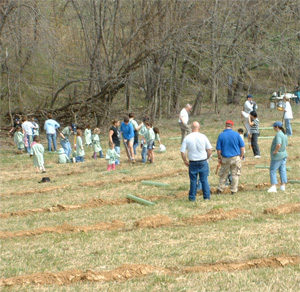
They learned how to dig a wedge shaped hole with a “dibble bar,” to plant the seedling with the roots pointed down, and to close the hole to prevent air pockets.
Parents pounded in wood stakes, and scouts attached plastic cone sleeves to protect the seedlings from deer.
Along with the planting, two fun nature activities were provided. With Gem Bingo helping, Phil Daley set up a streamside monitoring station where scouts conducted water quality tests and saw live specimens of the aquatic insects and fish found in small streams.
The participants learned that trees planted along a stream create a “riparian buffer” that helps build healthy streams.
The trees, brush, and grasses slow the flow of rain water, prevent soil and stream bank erosion, and filter sediment and other pollutants. The trees also create a natural buffer that provides wildlife habitat, shade to keep stream water cool, and food and shelter for fish and other aquatic organisms.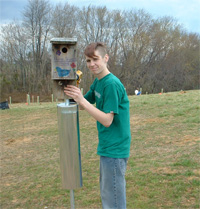
The second fun activity was the installation of blue bird nest houses under the direction of Nicole Hamilton and the help of Mary Dorsey-Lee and Brian Lee. The Girl Scouts painted six blue bird boxes with flowers and butterflies to make the birds feel welcomed. The decorated boxes were attached to metal poles along the edge of the rows of seedlings to create a blue bird trail in the new park. A local teen, Kyle Lee, is monitoring the blue bird boxes as part of a school science project. He reports that blue birds and tree swallows have already occupied the houses.

